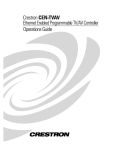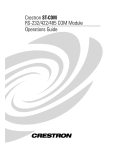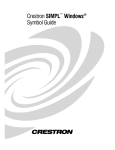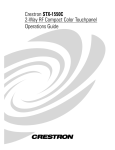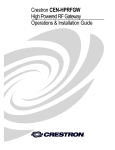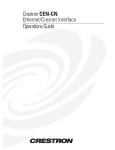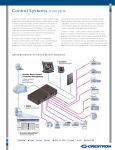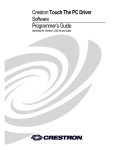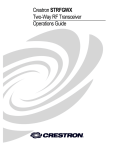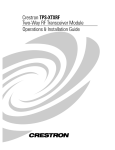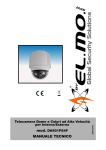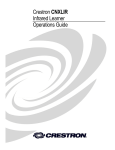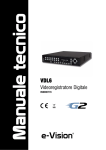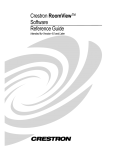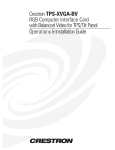Download Crestron CN-TVAV Specifications
Transcript
This document was prepared and written by the Technical Documentation department at: Crestron Electronics, Inc. 15 Volvo Drive Rockleigh, NJ 07647 1-888-CRESTRON Crestron CN-TVAV Programmable TV/AV Controller Contents Programmable TV/AV Controller: CN-TVAV 1 Description Functional Description Physical Description Leading Specifications Setup Cresnet Modular Cabling Cable Configuration for Programming Programming Cable Fabrication Specifications Special Considerations for Using the RS-232 Port for Uploading Programs Cable Configuration for Normal Operation Identity Code Loading Crestron Control Software Installing Crestron Development Tools Initial Setup File Types Obtaining Communications Troubleshooting Communications Loading the System Program Updating the CN-TVAV Programming with SIMPL™ Windows® or SIMPL+ Programming Modes Typical Programming Application Example Programs Problem Solving Troubleshooting Internal Fuse Replacement Further Inquiries Future Updates Return and Warranty Policies Merchandise Returns / Repair Service CRESTRON Limited Warranty Operations Guide - DOC. 5722B 1 1 2 6 7 7 8 9 10 11 12 13 13 14 15 18 20 21 22 24 25 28 29 30 30 30 33 33 34 34 34 Contents • i Crestron CN-TVAV Programmable TV/AV Controller Programmable TV/AV Controller: CN-TVAV Description Functional Description The CN-TVAV is a multi-purpose television/audio-visual (TV/AV) device controller that is compatible with SIMPL™ Windows® and can be used as a standard Crestron remote control system (herein referred to as the Cresnet system) peripheral or as a “smart” peripheral. As a standard Cresnet system peripheral, the CN-TVAV can be added as a Cresnet network device to a host Crestron control system with all logic, infrared (IR) drivers, and serial strings stored in the control system programming logic. In the “smart” peripheral mode, the CN-TVAV may be programmed to store and execute SIMPL and SIMPL+ programs. The CN-TVAV controls the ON/OFF and many or most functions of an attached TV or AV device. The unit provides operating power to the device and controls the device through a Crestron SmarTouch infrared probe (STIRP). The CN-TVAV also provides four Versiports ports (each capable of digital inputs/or digital outputs or analog inputs) for controlling or monitoring external equipment. The CN-TVAV may also be enabled and operated with optional Crestron handheld IR transmitters. To prevent interference from most standard IR frequencies and/or fluorescent lighting, the CN-TVAV and optional transmitters operate at 455 kilohertz (kHz). Contact Crestron customer service for further information. The CN-TVAV may be utilized as a “smart” peripheral, a standard Cresnet system peripheral, or a “mixed mode” peripheral. For descriptions of the three ways to perform different functions, refer to the following paragraphs. In Local Processing Mode, the CN-TVAV functions as a “smart” peripheral. The built-in CN-TVAV devices (IR Port, Versiport, Com Port, Power Sensor, and IR Gateway) are accessed and controlled by the SIMPL Windows program loaded into the CN-TVAV. NOTE: The CN-TVAV in the Local Processing Mode does not function as a “full scale” control system and support a local Cresnet system (ie. touchpanels, etc. The CEN-TVAV may be used as a device controller while supporting a local Cresnet system. Operations Guide - DOC. 5722B Programmable TV/AV Controller: CN-TVAV • 1 Programmable TV/AV Controller Crestron CN-TVAV The CN-TVAV does not support dynamic preset storage that may be required by certain modules, such as dynamic camera presets, etc. Having a simulated clock and simulated NVRAM, if power is lost, the clock and symbols utilizing NVRAM do not maintain previous settings. Therefore, the CN-TVAV may not be suitable for certain types of local processing applications. For further information, please contact Crestron customer service. In Remote Processing Mode, a CN-TVAV may be used as a peripheral within a host control system program. When this is done, all the functionality of the CN-TVAV (such as the IR Port, Versiport, Com Port, Power Sensor, and IR Gateway) is accessed via the host control system program with no programming within the CN-TVAV. For example, IR can be generated by the CN-TVAV by programming the host control system only. The Mixed Processing Mode is a combination of the Local Processing and Remote Processing Modes. For example, the Versiports can be programmed to control other equipment from the program in the CN-TVAV and the IR Port can be generated via the host control system (no IR driver loaded in the CN-TVAV). It is not recommended to communicate to a port of the CN-TVAV (such as the IR Port) through a program in the CN-TVAV itself and via a host control system at the same time. Physical Description Shown below is the STIRP and 5-pin connector plug that are supplied with the CN-TVAV. When connected to the IR port of the CN-TVAV and positioned near an attached TV or AV device, the STIRP (or other IR device) emits IR signals that control the attached device. The provided 5-pin connector plug shown may be connected to the I/O port of the CN-TVAV and used for digital inputs, digital outputs, and analog inputs to control and monitor up to four external devices. CN-TVAV Accessories STIRP (10 ft / 25.40 cm) 5-PIN CONNECTOR PLUG The CN-TVAV, shown on the next page, is housed in a black enclosure with silkscreened labels on the front and rear panels. On the front panel are 11 light-emitting diodes (LEDs) for indicating the status of the unit and of the attached device(s). All connections are made through the rear panel. There are four rubber feet on the base of the unit for stability and to prevent slippage. The CN-TVAV is also available as an international version. All of the features are identical with the exception of the international AC power requirements, power-in cord and power out receptacle, and unit nomenclature of CNI-TVAV. Throughout this operations guide, all references to CN-TVAV apply to both versions except where noted. 2 • Programmable TV/AV Controller: CN-TVAV Operations Guide - DOC. 5722B Crestron CN-TVAV Programmable TV/AV Controller CN-TVAV Physical Views 7.07 in (17.95 cm) CRESNET POWER OUT 6A MAX RS-232 POWER IN I/O IR 1 2 3 4 G 115 VAC 50-60HZ 6.6A MAX CRESTRON ELECTRONICS INC. ROCKLEIGH, N.J. 07647 USA 6.32 in (16.06 cm) TVAV CONTROL PWR INPUT-OUTPUT NET 1 2 3 4 TV/AV PWR RS-232 IR RXD TXD 1.70 in (4.32 cm) IR IN CRESTRON CN-TVAV CN-TVAV Ports Each CN-TVAV rear panel port has a silk-screened label. For the descriptions of the ports, refer to the two diagrams below and the paragraphs on the next two pages. CN-TVAV Rear Panel CRESNET POWER OUT 6A MAX RS-232 I/O 1 2 3 4 G POWER IN IR CRESTRON ELECTRONICS INC. ROCKLEIGH, N.J. 07647 USA 115 VAC 50-60HZ 6.6A MAX CNI-TVAV (International Version) Rear Panel CRESNET POWER OUT 5A MAX RS-232 I/O 1 2 3 4 G CRESTRON ELECTRONICS INC. ROCKLEIGH, N.J. 07647 USA Operations Guide - DOC. 5722B POWER IN IR 230 VAC 50-60HZ, 5.5A MAX Programmable TV/AV Controller: CN-TVAV • 3 Programmable TV/AV Controller Crestron CN-TVAV CRESNET This 6-pin, 6-position RJ11 modular jack is used to connect the CN-TVAV to a control system so it may be accessed as a Cresnet peripheral. Refer to the table below for the pinouts. CAUTION: If making connections to RJ11 ports, use the Crestron 6-conductor modular cable provided, do not use 6-conductor telephone cables. Telephone cables are wired in a crisscross fashion and are not compatible with Crestron equipment. For further information, refer to the latest revision of Modular Cable Requirements (Doc. 5682). This document can be obtained from the Products page (PRODUCT MANUALS section, manuals for software and wiring diagrams section) or Downloads page (CABLES and MANUAL Libraries) of Crestron’s website (www.crestron.com). Search for MODULAR.PDF. New users are required to register in order to obtain access to the FTP site. NOTE: This port does not provide 24 direct current volts (VDC) for powering other equipment. CRESNET Port Pinouts PIN DESCRIPTION PIN DESCRIPTION 1* 2 3 Not Connected Not Connected Net+ (Cresnet Y data) 4 5 6 Net- (Cresnet Z data) GND GND * While facing the rear panel of the unit, pin 1 is located at the upper-left of the port. RS-232 This 6-pin, 6-position RJ11 modular jack is used for control of RS-232 peripheral devices and to communicate with a personal computer (PC) when programming the CN-TVAV. Prior to switching between the programming mode and the RS-232 port, refer to “Special Considerations for Using the RS-232 Port for Uploading Programs” on page 10. Refer to the table below for the pinouts. RS-232 (PC) Port Pinouts PIN DESCRIPTION PIN DESCRIPTION 1* 2 3 CTS (Clear to Send) GND RxD (Received Data) 4 5 6 TxD (Transmitted Data) RTS (Request to Send) Not Connected * While facing the rear panel of the unit, pin 1 is located at the upper-left of the port. I/O (1-4, G) Pins 1-4 of this Versiport may individually be used as programmable digital inputs, digital outputs, analog inputs, or any combination of each. Digital inputs are rated 0 - 24VDC, 20K ohms input impedance, logic threshold 1.25VDC. Digital outputs offer 250 milliamp sink from maximum 24VDC; catch diodes provide transient protection for use with “real world” loads. Analog inputs are rated 0 - 10VDC, protected to 24VDC maximum, 20K ohms input impedance; pin-programmable 2K ohms pullup resistor to +5V. The pin labeled G is the common ground for pins 1-4. IR This 3.5mm mini-jack is used by the STIRP (provided) to control an attached TV or AV device. The jack accepts mono (2-conductor) or stereo (3-conductor) mini-plugs. Multiple IR drivers may be loaded into the CN-TVAV and, with the use of a Crestron ST-SPL IR Splitter, up to five AV devices may be controlled. 4 • Programmable TV/AV Controller: CN-TVAV Operations Guide - DOC. 5722B Crestron CN-TVAV Programmable TV/AV Controller POWER OUT WARNING: When the POWER IN cord is plugged into an energized outlet, POWER OUT becomes energized. Crestron recommends connecting the TV or AV device before plugging the POWER IN cord into an outlet. NOTE: The maximum continuous current from the POWER OUT under any external load shall not exceed a current limit that is suitable for the minimum wire gauge and maximum length used for the interconnecting cable(s). NOTE: The maximum load applied to the POWER OUT shall not exceed the rated voltage and current as specified on the unit. This receptacle provides AC power (refer to the rear panel label for details) for a TV or AV device. The receptacle is hard-wired to the POWER IN cord and is not protected with a fuse. When programmed to sense whether the attached device is OFF or ON, a large current is used to indicate that the attached device is ON and the absence of (or very low) current indicates the device is OFF. If the CN-TVAV (or control system) detects that the device is ON, the program can be coded to not allow the CN-TVAV to attempt to turn it ON, which would inadvertently turn it OFF. This is true if the IR driver does not have discrete ON and OFF functions, but only a POWER function. POWER IN This attached power cord supplies operating AC power (refer to the rear panel label and/or “Leading Specifications” section on page 6 for details) to the CN-TVAV and the POWER OUT port. An internal fuse electrically protects the CN-TVAV circuitry from excessive power input. CN-TVAV Indicators There are 11 LED indicators located on the front panel of the CN-TVAV. For the descriptions of the front panel indicators, refer to the diagram below and the following paragraphs. CN-TVAV Front Panel TVAV CONTROL PWR NET CRESTRON INPUT-OUTPUT 1 2 3 4 TV/AV PWR IR RS-232 RXD TXD IR IN CN-TVAV PWR This LED (green) is illuminated while the CN-TVAV power-in cord is plugged into an energized VAC outlet. There is no ON/OFF switch for the CN-TVAV. NET This LED (yellow) illuminates when communication with Cresnet peripherals is occurring or while processing commands from the PC (i.e., uploading, programming). The connections to these devices are made through the rear panel CRESNET port. Operations Guide - DOC. 5722B Programmable TV/AV Controller: CN-TVAV • 5 Programmable TV/AV Controller Crestron CN-TVAV INPUT-OUTPUT These four LEDs (red) labeled 1-4 illuminate while the corresponding input or output device that is connected to the rear panel I/O is active. TV/AV The PWR (green) LED is illuminated while the current sensor is detecting that the TV or AV device connected to the power-out receptacle is ON. The IR (red) LED illuminates when IR signals are being sent out the IR port. RS-232 The RXD (red) LED illuminates when the CN-TVAV is receiving serial data from the RS-232 port. The TXD (red) LED illuminates when the CN-TVAV is sending data to the port. NOTE: The IR receiver, for use with an optional Crestron handheld IR transmitter, is located behind the red lens between the RS-232 and IR IN indicators. IR IN This LED (red) illuminates when the CN-TVAV receives a valid IR code from an optional Crestron handheld transmitter. Leading Specifications The table below provides a summary of leading specifications for the CN-TVAV. Dimensions and weight are rounded to the nearest hundredth unit. Leading Specifications of the CN-TVAV SPECIFICATION Power Input Requirements: Power Output: US International US International DETAILS 115VAC, 50-60 Hz, 6.6A maximum 230VAC, 50-60 Hz, 5.5A maximum 115VAC, 50-60 Hz, 6A maximum 230VAC, 50-60 Hz, 5A maximum Internal Fuse IR Reception Frequency IR Reception Angle SIMPL Windows CEN/CN-TVAV Update File CNMSX-AV/Pro Update File CNRACKX/-DP Update File MaxAnalogSignals MaxDigitalSignals MaxNVRAM MaxProgramSize: Maximum CN-TVAVs per CNMSX control system 1A, 250V, Fast/Quick Acting 1 455kHz Approximately 30o centered on IR receiver Version 1.61.13 or later 2 Version 51205V.UPZ or later 3 Version 51226X.UPZ or later 3 Version 51226W.UPZ or later 3 2048 4 16373 4 NA 5 256K 25 if touchpanels are used, 30 if no touchpanels are used 6 Dimensions & Weight Height: 1.70 in (4.32 cm) Width: 7.07 in (17.95 cm) Depth: 6.32 in (16.06 cm) Weight: 3.54 lb (1.61 kg) 7 6 • Programmable TV/AV Controller: CN-TVAV Operations Guide - DOC. 5722B Crestron CN-TVAV Programmable TV/AV Controller 1 The listed internal fuse is available from Wickmann (www.wickmannusa.com, part number 3701100041) and larger commercial retailers. 2 The latest software version can be obtained from the What’s New page (SIMPL Windows section) or Downloads page (SIMPLWIN Library) of Crestron’s website (www.crestron.com). New users are required to register in order to obtain access to the FTP site. 3 Filenames for update files have a UPZ extension and can be obtained from the What’s New page (Control Systems Update Files section) or Downloads page (OPSYS Library) of Crestron’s website. Update files are designed for specific devices. If an update file is loaded into a device other than for which it was intended, it may lockup the device that would then have to be returned to Crestron. Update files with a “S” designator for the ST-CP, “V” designator are for CEN/CN-TVAV, “W” for CNRACKX/-DP, and “X” for the CNMSX-AV/Pro. These devices are able to recognize and reject incorrect update files. However, when updating, do not ignore any Crestron Viewport warning prompts or messages. 4 Maximum number of SIMPL Windows analog and digital signals that CN-TVAV can process. 5 The CN-TVAV has a simulated clock and simulated NVRAM. If power is lost, the clock and symbols utilizing simulated NVRAM do not maintain previous settings. 6 Due to program size in the CNMSX, the recommended limit of CN-TVAVs programmed into a CNMSX using the CNXENET+ card is 25 if each room (CNTVAV) also contains a touchpanel. With this configuration, (depending upon the wiring, it may be advisable to add a CNXHUB), 20 sources may be programmed with the 25 rooms. If there are no touchpanels are utilized, the recommended limit of CN-TVAVs is 30. If a Cresnet system has more rooms, either connect additional CN-TVAVs to another CNMSX or utilize CEN-TVAVs. 7 The weight listed is the combined weight of the CN-TVAV, STIRP, 5-pin connector, and modular cable. As of the date of manufacture, this unit has been tested and found to comply with specifications for CE marking. NOTE: This device complies with part 15 of the FCC rules. Operation is subject to the following two conditions: (1) this device may not cause harmful interference, and (2) this device must accept any interference received, including interference that may cause undesired operation. Setup Cresnet Modular Cabling NOTE: If making network connections to the Cresnet peripherals, refer to the latest revision of the Crestron Network Modular Cable Requirements (Doc. 5682). This document can be obtained from the Products page (PRODUCT MANUALS section, manuals for software and wiring diagrams section) or Downloads page (CABLES and MANUAL Libraries) of Crestron’s website (www.crestron.com). Search for MODULAR.PDF. Operations Guide - DOC. 5722B Programmable TV/AV Controller: CN-TVAV • 7 Programmable TV/AV Controller Crestron CN-TVAV When calculating the wire gauge for a particular Cresnet run, the length of the run and the load factor of each network unit to be connected must be taken into consideration. If Cresnet units are to be daisy-chained on the run, the load factor of each unit to be daisy-chained must be added together to determine the load factor of the entire chain. If the unit is a home-run from a Crestron system power supply network port, the load factor of that unit is the load factor of the entire run. The length of the run in feet and the load factor of the run should be used in the resistance equation below to calculate the value on the right side of the equation. Resistance Equation R < 40,000 L x LF Where: R = Resistance (refer to next table). L = Length of run (or chain) in feet. LF = Load factor of entire run (or chain). The required wire gauge should be chosen such that the resistance value is less than the value calculated in the resistance equation. Refer to the table below. Wire Gauge Values RESISTANCE (R) WIRE GAUGE 4 16 6 18 10 20 15 22 Cable Configuration for Programming The CN-TVAV may be programmed through the host control system or directly via the local RS-232 port. To program the CN-TVAV at the RS-232 port, a modular cable, an RJ11 to DB9F adapter and 6-conductor modular cable are required. These components are not supplied but are part of the SmarTouch Programming Kit (ST-PK). If available, use these components. When programming, refer to the figure on the next page for a typical connection diagram. Complete the following steps in the order provided to ensure proper connection. WARNING: When the POWER IN cord is plugged into an energized outlet, POWER OUT becomes energized. Crestron recommends connecting the TV or AV device before plugging the POWER IN cord into an outlet. NOTE: The following procedure assumes that a touchpanel is being used as the user interface. If a wireless hand-held transmitter is utilized, no connections to a user interface need to be made. NOTE: The RJ11 to DB9F adapter is available commercially or contact Crestron customer support for part number 15556. If not available, refer to “Programming Cable Fabrication Specifications” on page 9. 8 • Programmable TV/AV Controller: CN-TVAV Operations Guide - DOC. 5722B Crestron CN-TVAV Programmable TV/AV Controller NOTE: While facing the rear panel of the unit, pin 1 of the RS-232 port is located at the upper-left of the port. Typical Connections when Programming TO PC DURING PROGRAMMING CRESNET TO VAC OUTLET POWER OUT 6A MAX RS-232 I/O 1 2 3 4 G POWER IN IR CRESTRON ELECTRONICS INC. ROCKLEIGH, N.J. 07647 USA 115 VAC 50-60HZ 6.6A MAX 1. Attach the RJ11 to DB9F adapter to one end of the 6-conductor modular cable. (Not required if a PC to Control Processor cable is fabricated.) 2. Attach the RJ11 connector (of the adapter and cable combination) to the RS-232 port. 3. Attach the DB9 connector (of the adapter and cable combination) to an available COM port on the PC. 4. Attach the RJ11 connector of the modular cable supplied with the touchpanel (or fabricated touchpanel to control processor cable) to the CN-TVAV port labeled CRESNET. 5. Attach the other connector of the modular (or fabricated) cable to the touchpanel. 6. Plug CN-TVAV power cord into VAC wall outlet or power strip. Programming Cable Fabrication Specifications In the event that modular cables or RJ11 to DB9F adapter is not available to program the CN-TVAV at the RS-232 port, the table below and the diagram on the next page are provided so that the cable can be fabricated. NOTE: The RJ11 to DB9F adapter is available commercially or contact Crestron customer service for part number 15556. RJ11 Modular Cable Pinouts PIN DESCRIPTION PIN DESCRIPTION 1* 2 3 CTS (Clear to Send) GND RxD (Received Data) 4 5 6 TxD (Transmitted Data) RTS (Request to Send) Not Connected * While facing the rear panel of the unit, pin 1 is located at the upper-left of the port. Operations Guide - DOC. 5722B Programmable TV/AV Controller: CN-TVAV • 9 Programmable TV/AV Controller Crestron CN-TVAV PC to Control Processor (CN-TVAV) Cable Specification TO PC COM PORT REAR VIEW OF CONNECTOR 6 7 8 9 1 2 2 3 5 3 4 5 7 8 TO RS-232 PORT 1 2 3 4 5 6 CTS GND RxD TxD RTS n/c PART # AWC10152-A 1 PART # 641337 (9-PIN FEMALE) PART # 748047-1 Special Considerations for Using the RS-232 Port for Uploading Programs The CN-TVAV has a single RS-232 console port that is used for uploading programs and communicating with RS-232 equipment for control purposes. Since the port is shared, the operation is slightly different from standard Crestron control systems that have a dedicated RS-232 console ports. When a program is loaded into a CN-TVAV that uses the TVAVCOM-1 port, the program will initialize but the shared port will still be attached to the console. The program runs normally, but the TVAVCOM-1 port will effectively be “disconnected” from the system. This is done so other configurations (such as uploading SIMPL+ modules, setting the IP Table, etc.) can be done. After the program is rebooted (using F10 in the Viewport or cycling operating power), the shared port is taken over by the TVAVCOM-1 port (if the TVAVCOM-1 symbol is present in the program) when the SIMPL program initializes. Note that SIMPL Windows will not convert the TVAVCOM-1 port if there are no signals or data coded in the port, or if the symbol is commented out. When the program initializes, the normal TVAV bootup messages will be issued out the TVAVCOM-1 port, i.e.: TVAV Monitor v5.10.13 - 03/07/00 - interrupt serial i/o 512k flash memory, 512k SRAM, segment =F900 Press <esc> now to enter debug monitor If there is a device hooked up to the TVAVCOM-1 port, the bootup message may be treated as false characters and cause device errors. It is possible to set the baud rate to DISABLE (pressing F8 while in the Viewport and selecting DISABLE) for the console port. This will cause the initial bootup message to not be displayed. In order to obtain communications with the CN-TVAV through the RS-232 port, the following methods can be used: 10 • Programmable TV/AV Controller: CN-TVAV Operations Guide - DOC. 5722B Crestron CN-TVAV Programmable TV/AV Controller Set Baud Rate to Obtain Communication BAUD RATE STEPS TO PERFORM If the baud rate was 1. Set the Viewport to 38400 N81 baud via Setup | Communications Setting. set to 'disable' for 2. Disconnect the AC power from the CN-TVAV. the console. If the baud rate was 3. Reconnect AC power to the CN-TVAV. 4. Within the first 5-seconds, press the BREAK character set to a rate other ALT-K) in the Viewport and observe the standard CN-TVAV than 'disable' for the bootup message. console but the rate 5. When the following message is displayed, press the spaceis unknown. bar to abort running the program. Otherwise, the CN-TVAV will boot, the TVAVCOM-1 symbol will take over, and the console will be set to the DISABLE rate. Booting from Flash Prom 6E00 Press <space> for cold start 6. To set the console baud rate, press F8 and select a new baud rate. This will force the console to show the bootup messages at bootup time. If the baud rate was 1. Set the Viewport to the baud rate the console is operating at or use Establish Communications (Alt-B) from the set to a rate other Diagnostics Menu. than 'disable' and 2. Press BREAK (ALT-K) three times in succession and the rate is known. observe the following reply: TVAV Console Enabled The console port is always accessible, regardless of whether or not the program contains a TVAVCOM-1 port, if the console connection is established via “Establish Remote Console Connection” on page 20. To prevent the console switchover during program development, the TVAVCOM-1 port may be commented out. If the TVAVCOM-1 port is not programmed in SIMPL Windows (if the definition is present but the Port contains no data), then the console port will never be taken over and is always accessible. Cable Configuration for Normal Operation When operating the CN-TVAV under normal conditions, refer to the figure on the next page for a typical connection diagram. WARNING: When the POWER IN cord is plugged into an energized outlet, POWER OUT becomes energized. Crestron recommends connecting the TV or AV device before plugging the POWER IN cord into an outlet. CAUTION: If making connections to the CRESNET modular port, do not use 6-conductor telephone cables. Telephone cables are wired in a crisscross fashion and are not compatible with Crestron equipment. Use the modular cable provided. CAUTION: If making connections to the Cresnet peripherals from the CRESNET port, refer to “Cresnet Modular Cabling” on page 7. NOTE: If making connections to Cresnet peripherals from the CRESNET port, refer to “CRESNET” on page 4 for the port description and pinouts. Operations Guide - DOC. 5722B Programmable TV/AV Controller: CN-TVAV • 11 Programmable TV/AV Controller Crestron CN-TVAV NOTE: Refer to the latest revision of the STIRP Installation Instructions (Doc. 5674) for details to attach the STIRP near the IR sensor window of the TV or AV device. This document can be obtained from the Products page (PRODUCT MANUALS section, hardware section) or Downloads page (MANUAL Library) of Crestron’s website (www.crestron.com). Search for STIRP.PDF. New users are required to register in order to obtain access to the FTP site. NOTE: The power plug is used to connect or disconnect power from the unit. Other than making the power connection last, complete the connections in any order. NOTE: An optional Crestron handheld IR transmitter must have an unobstructed line-of-sight to the IR receiver of the CN-TVAV. Make sure nothing is between the transmitter and the CN-TVAV that would prevent maximum signal reception. Typical Connections for Normal Operation TO CRESNET PERIPHERALS (DURING MIXED MODE) OR HOST CONTROL SYSTEM (REMOTE OR MIXED MODE) CRESNET TO STIRP OR OTHER IR DEVICE TO VAC OUTLET POWER OUT 6A MAX RS-232 I/O 1 2 3 4 G POWER IN IR CRESTRON ELECTRONICS INC. ROCKLEIGH, N.J. 07647 USA TO RS-232 PERIPHERALS TO OTHER PERIPHERALS 115 VAC 50-60HZ 6.6A MAX TO TV OR AV DEVICE Identity Code Every equipment and user interface within the Cresnet network requires a unique identity code (NET ID). These codes are recognized by a two-digit hexadecimal number from 03 to FE. When used in the Remote Processing Mode or Mixed Processing Mode, each CN-TVAV in the Cresnet system needs a NET ID that matches an ID code specified in the SIMPL Windows program. The NET ID of the CN-TVAV is factory set to 50. The NET IDs of multiple units must all be unique and changed from a PC via SIMPL Windows or VisionTools™ Pro-e (VT Pro-e). NOTE: VT Pro-e is a Windows compatible software package for creating Crestron touchpanel screen designs. The method for changing the unit’s NET ID is identical regardless of the software chosen. Complete the following steps to change the NET ID. 1. Attach one of the CN-TVAVs to the control system (verify that the software is running). 12 • Programmable TV/AV Controller: CN-TVAV Operations Guide - DOC. 5722B Crestron CN-TVAV Programmable TV/AV Controller 2. From the SIMPL Windows or VT Pro-e menu, select Tools | Viewport to open the Crestron Viewport. 3. From the Viewport menu, select Functions | Set Network ID. The software checks the baud rate and then opens the “Set Network ID” dialog box. 4. In the “Set Network ID” dialog box, select the CN-TVAV from the Current Network Devices text window. 5. From the Choose the new network ID for the selected device (Hex): text box, select the new Net ID for the CN-TVAV. 6. Click Set ID to initiate the change. This will display the “ID command has been sent” dialog box. 7. In the “Command Complete” dialog box, click OK. 8. In the Current Network Devices text window, verify the new NET ID code. 9. In the “Set Network ID” dialog box, click Close. NOTE: The new NET ID code may also be verified by selecting Diagnostic | Report Network Devices in the Viewport. 10. Repeat this procedure for each CN-TVAV to be added to the Cresnet system. Loading Crestron Control Software Crestron control software is available in an electronic form; CD-ROM, email, or from Crestron’s website. Regardless of how and from where the software is obtained, this section provides the necessary installation steps. Before performing the procedures in this section, refer to “Cable Configuration for Programming” on page 8 for cabling instructions. Installing Crestron Development Tools Crestron provides software tools for programming the CN-TVAV. Even if only the control software is being loaded into the hardware and there are no plans to do any programming, some Crestron development software must be installed on the PC. Currently, Crestron programming is accomplished with the use of the following development tools listed in the table shown on the next page. NOTE: If the intent is to load software developed elsewhere, install SIMPL Windows only. To program the CN-TVAV, install all three applications. NOTE: The latest versions of these applications are available from Crestron’s website (www.crestron.com). Crestron ControlCD also contains a version (which may not be as current as the website version). To obtain a free copy of the CD-ROM, contact Crestron at 1-888-CRESTRON [1-888-273-7876]. Alternatively, complete a literature request from the Crestron website to obtain one. Operations Guide - DOC. 5722B Programmable TV/AV Controller: CN-TVAV • 13 Programmable TV/AV Controller Crestron CN-TVAV Crestron Development Tools DEVELOPMENT TOOL SIMPL Windows VT Pro-e DEAL for Windows DESCRIPTION Used to program the CN-TVAV. Used to design touchpanel layouts and to program SmarTouch Systems. Used for learning (using the optional CNXLIR) and maintaining IR driver files. Before installing any development tools, confirm that all other applications such as Microsoft® Office, etc. are closed. The website and CD provide instructions for installing the various tools. When initiating a custom install from the CD, the user is presented with a list of the software programs, documentation, and other resources. For each item, set or clear a checkbox to the left of the item to direct the installation program whether to install that component onto the hard drive. The size of the each item installed determines how much disk space is required. Each development tool contains a help file that can be opened from the Help pull-down menu. Refer to these files for additional information. Initial Setup To avoid any procedural errors, follow the steps in the order provided. After installing the desired development tool, various job files may be obtained from Crestron or other sources. Using Windows Explorer™, complete the following steps. These steps ensure that all job files reside on the hard drive (C:) in the Directory \CRESTRON\PROJECTS\MYJOB. 1. Navigate to the SIMPL directory on the hard drive. Assume that the default install directory is C:\CRESTRON. 2. Create a new folder for the project files. Although the folder where the files are placed is not critical, it is easier to manage projects if a logical structure is created. For example, create a new folder, called PROJECTS, underneath the CRESTRON directory. Create another folder, called MYJOB, under PROJECTS for the current job. The resulting pathname is C:\CRESTRON\PROJECTS\ MYJOB. 3. Copy the supplied files into the folder created in the last step. The source of the file determines the procedure. From a floppy disk: Most floppy disks sent from Crestron contain a common directory structure designed to make it easier to organize files. Copy the entire contents of the disk(s) including the directory structure. From an EXE file: If a job is downloaded from the Crestron website or is received via email, all files may have been compressed into a single, self-extracting archive. This archive has an EXE extension. First, copy the EXE file into the directory stated in step 1, then doubleclick on the file name to begin decompressing the file. The program asks for a location for the extracted files. In this case, browse for the same directory where the archive was copied. (Once files are extracted, retain the original EXE file in case files need to be restored.) From a ZIP file: If the downloaded job is from Crestron’s website or e-mail, all files may have been compressed into an archive file with a ZIP extension. For this ZIP file to be used, in SIMPL Windows, select File | Import Archived Program. This will open a dialog box similar to the one shown on the next page. 14 • Programmable TV/AV Controller: CN-TVAV Operations Guide - DOC. 5722B Crestron CN-TVAV Programmable TV/AV Controller Import an Archived (ZIP File) Program Dialog Box The job may be copied to any folder or directory, and the User IR, User Module, and SIMPL+ files will be copied to the proper directories. If a version of SIMPL Windows lower than 1.30.01 is being used, copy the ZIP file into the job directory stated in step 1, then extract the files with a program called WinZip. Obtain a copy of this program from their website (www.winzip.com) on the Internet. Extract the files into the same directory where the archive was copied. Once files are extracted, retain the original ZIP file in case the files need to be restored at any point. The User IR, User Module, and SIMPL+ files will need to be copied to their proper directories manually. File Types There are quite a few file types involved with Crestron control software. This section explains the different types that might be encountered in each directory. In many cases, the supplied software is grouped into a number of subdirectories. The intent is to keep files organized. For example, after copying the files to the hard disk, the directory structure may appear as shown below. Possible Directory Structure Operations Guide - DOC. 5722B Programmable TV/AV Controller: CN-TVAV • 15 Programmable TV/AV Controller Crestron CN-TVAV NOTE: In this example, the Vt3501 and Vt3502directories represent two touchpanels that are part of the entire remote control system. Consult the connection sheets or other supplied information to determine which directory corresponds to a given touchpanel. Ops Subdirectory - The files (described in the table below) in this subdirectory contains the CN-TVAV operating system with which the program was tested. Ensure that the operating system version currently loaded is equal to or newer than the version included here, so that the program runs properly. For help with uploading an operating system, refer to “Updating the CN-TVAV” on page 22. File Types in Ops Subdirectory FILE TYPE .upz DESCRIPTION This is a control system file. For more information regarding these files, refer to "Updating the CV-TVAV". Programs Subdirectory - The files (described in the table below) in this subdirectory contain the system program. This is the main program that loads into the CN-TVAV and determines the exact functionality. File Types in Programs Subdirectory FILE TYPE DESCRIPTION .asv .bin SIMPL Windows auto-save file. This is the executable code for the CN-TVAV. This is the default IP Table that contains the IP addresses of all of the ethernet devices in the system. It is generated when the program is compiled. This file contains information required by Test Manager (see SIMPL Windows help for more information) for debugging programs in realtime. It is generated each time the program is compiled. This is the SIMPL-C file that is generated from the SMW file when a program is compiled. In SIMPL Windows version 1.18 or lower, this file is what actually gets compiled into the BIN file. In versions after 1.18, this file may or may not be generated and but is not required. This is the SIMPL Windows program file. It contains the source code for the main system program. SIMPL Windows program backup file. .dip .sig .smp .smw .sm2 Userdb Subdirectory - The files (described in the table below) in this subdirectory is a user database IR driver that is needed to interface with certain IR-controlled devices. This driver differs from Crestron database IR drivers in that the former are included as part of a Crestron Database. File Types in Userdb Subdirectory FILE TYPE DESCRIPTION .ir This is a user IR driver file. It is needed during the convert/compile process in order to properly compile the program. If recompilation of the program is necessary, use the Import Program option or copy any IR files received into the default user database directory (see SIMPL Windows help for more information). Alternatively, set the SIMPL Windows userdb directory to the directory where the macros exist. (In SIMPL Windows, this is accomplished from the Directories tab by selecting Edit | Preferences.) 16 • Programmable TV/AV Controller: CN-TVAV Operations Guide - DOC. 5722B Crestron CN-TVAV Programmable TV/AV Controller Usrmodule Subdirectory - The files (described in the table below) in this subdirectory are user modules, or special sub-programs that are integral parts of the main program. These differ from Crestron modules in that the former are supplied as part of the development software. File Types in Usrmodule Subdirectory FILE TYPE .umc .um2 DESCRIPTION This is a user module file. It is needed during the convert/compile process in order to properly compile the program. To recompile the program, use the Import Program option or copy any UMC files received into the default user module directory (see SIMPL Windows help for more information). Alternatively, set the SIMPL Windows usermodule directory to the directory where the modules exist. (In SIMPL Windows, this is accomplished from the Directories tab by selecting Edit | Preferences.) This is the user module backup file. UsrSPlus Subdirectory - The files (described in the table below) in this subdirectory contain the User SIMPL+ modules used in this system. To recompile the program, use the Import Program option or copy the USH and USP files received into the default user SIMPL+ directory. Alternatively, set the SIMPL Windows user SIMPL+ directory to the directory where the modules exist. File Types in UsrSPlus Subdirectory FILE TYPE .csz .uf .ush .usp DESCRIPTION Crestron SIMPL+ archive. This archive contains all of the SIMPL+ executable code (from both user modules and Crestron modules) that the Transfer Program dialog will send to the CN-TVAV. User SIMPL+ compiled file. This contains the executable SIMPL+ code for the CN-TVAV. User SIMPL+ header file. This file details how SIMPL Windows should model the gate as a symbol (i.e. how many inputs, outputs, etc.). User SIMPL+ source code module. This file gets compiled by the SIMPL+ environment and also is editable by the user. Touchpanel Directory - The files (described in the table below) in this subdirectory contain touchpanel projects (for example, Vt3501 and Vt3502 in the previous diagram titled Possible Subdirectory Structure). Each project describes the exact graphical display of the touchpanel. File Types in Touchpanel Subdirectory FILE TYPE DESCRIPTION .bmp, .pcx, These are graphic files that are needed by VisionTools for Windows or .dib (VTW) for recompiling touchpanel projects. This is the compiled touchpanel project file. This file is uploaded to the .hex panel. Logic files for existing SmarTouch products (such as ST-1500/ 1500C) .lgc that use VTW. Logic files for existing SmarTouch products (such as ST-1500/ 1500C .vti and .vtl or ST-1550/1550C) that use VTPro-e. This is the only VT Pro-e file required for a given project. It replaces .vtp the PRJ, PGF, and graphic (BMP, PCX, etc.) files that were part of VTW projects. Operations Guide - DOC. 5722B Programmable TV/AV Controller: CN-TVAV • 17 Programmable TV/AV Controller Crestron CN-TVAV Obtaining Communications To upload program files to the CN-TVAV, it is necessary to first obtain communication with the device. Communication with the CN-TVAV is established via the local RS-232 port and is required to set IP address initially. Communication via RS-232 Port Prior to completing the following steps, be sure the communication cable is properly connected as described in “Cable Configuration for Programming” on page 8. 1. Make sure that no programs accessing the COM port of the PC are running. 2. Select Start | Programs | Crestron | SIMPL Windows to start SIMPL Windows. NOTE: SIMPL Windows may open with an opening splash screen and may display the “What do you want to do?” dialog box. If so, close the dialog box and continue. 3. As shown below, select Tools | Viewport to open the Crestron Viewport. Accessing the Viewport 4. As shown below, select Tools | Viewport to open the Crestron Viewport. Refer to diagram below. From the Setup menu, verify that Auto Baud Search is checked. Verifying Auto Baud Search 18 • Programmable TV/AV Controller: CN-TVAV Operations Guide - DOC. 5722B Crestron CN-TVAV Programmable TV/AV Controller 5. Refer to diagram below. While the Viewport is displayed, select Setup | Communications settings (alternatively, depress Alt+D) to open the Port Settings dialog box. Accessing the Port Settings Dialog Box 6. Select the appropriate connection type. (If using the RS-232 port of the CN-TVAV for the connection to the PC, refer to “Special Considerations for Using the RS-232 Port for Uploading Programs” on page 10 for further information.) Verify that an available COM port (COM 1 is shown below) is selected. Set the baud rate to 38400, the parity to None, the data bits to Eight, and the stop bits to One. Refer to the dialog box shown for the remaining settings and click the OK button to save the settings and close the box. Port Settings Dialog Box Operations Guide - DOC. 5722B Programmable TV/AV Controller: CN-TVAV • 19 Programmable TV/AV Controller 7. Crestron CN-TVAV Select Diagnostics | Check Operating System Version (alternatively, depress F5) from the Viewport. The Viewport may display a window as it scans various baud rates. Eventually, a message should appear in the Incoming section showing a version number. Such a response indicates that communications have been established. If a “No Communications with Rack” error message opens, proceed to “Troubleshooting Communications” on page 20. If the baud rate of the CN-TVAV was something other than 38400, the software automatically adjusts the baud rate to 38400. Establish Remote Console Connection Instead of communicating by plugging into each CN-TVAV in a large installation via RS-232 in order to upload programs/firmware/etc., the CN-TVAV console can be accessed from the control system to which it is a peripheral. Complete the following steps to establish communication with the CN-TVAV. 1. If using the Stand-alone Viewport, open the Viewport and proceed to step 4. To access the Viewport via SIMPL Windows, select Start | Programs | Crestron | SIMPL Windows to start SIMPL Windows. NOTE: SIMPL Windows may open with an opening splash screen and may display the “What do you want to do?” dialog box. If so, close the dialog box and continue. 2. Select Tools | Viewport to open the Crestron Viewport. 3. Refer to the documentation supplied with the host control system and verify communication with the host control system. 4. From the Viewport menu, select Remote | Remote Console | Connect as shown below. Viewport Remote Console Connect Function 5. Observe the Viewport connect to the CN-TVAV. Troubleshooting Communications If communications with the CN-TVAV has not been established, follow the steps in this section to help remedy the problem. 1. If a program is already loaded into CN-TVAV, refer to “Special Considerations for Using the RS-232 Port for Uploading Programs” on page 9 for further information. 2. Verify that the cable being used is correct. (If cable is not available, refer to “Programming Cable Fabrication Specifications” on page 9.) 20 • Programmable TV/AV Controller: CN-TVAV Operations Guide - DOC. 5722B Crestron CN-TVAV Programmable TV/AV Controller 3. Repeat the “Communication via RS-232 Port” procedure on page 18 to establish communications. 4. Verify that the proper COM port on the PC has been selected. Some PCs have more than one COM port, some of which may be internal (e.g., for a modem). If verification can not be made, consult the user’s manual or contact the PC manufacturer. 5. Repeat steps 5 and 6 of the “Communication via RS-232 Port” procedure on page 18 to re-initialize communications. Loading the System Program To load the system program into the CN-TVAV, use the Crestron Viewport or the Transfer Program option in SIMPL Windows. For consistency, the following procedure uses the Viewport. To upload a BIN file into the CN-TVAV, complete the following steps in the order provided. 1. If the Crestron Viewport is not open, select Tools | Viewport to open the Viewport to connect to the CN-TVAV. 2. Select File Transfer | Send Program (alternatively, depress Alt+P) to open the Cresnet Simpl Program dialog box. 3. Use the Browse button to locate the supplied BIN file. 4. As shown below, click the Send Program button to initiate program upload to the CN-TVAV. A “Transfer in Progress” dialog box opens, but no response is required. If SIMPL+ files are present and the SIMPL+ Program(s) option is checked in the “What to Send” field, the associated files will be transferred after the program is transferred. Cresnet Simpl Program Dialog Box Operations Guide - DOC. 5722B 5. When a Query dialog box opens to create the permanent memory image, click No. 6. After transferring the program file, click the Check Program button to ensure that the file loaded properly. The information in the Current Program field of the Cresnet Simpl Program dialog box should update and display the file currently loaded. If the information does not update, repeat steps 3 through 5 of this procedure. If this does not remedy the problem, contact Crestron customer service for assistance. Programmable TV/AV Controller: CN-TVAV • 21 Programmable TV/AV Controller Crestron CN-TVAV Updating the CN-TVAV Much like a Crestron control system, the CN-TVAV contains an Operating System and a Monitor ROM. Although both are separate components, they are packaged together in a single file referred to as a Control System Update File. Control system update files have the UPZ extension. It is often necessary to update a control system or CN-TVAV if new features have been implemented (such as support for new hardware or new language constructs) or if programming "bugs" have been corrected. CAUTION: Update files are designed for specific devices. If an update file is loaded into a device other than for which it was intended, it may lockup the device that would then have to be returned to Crestron. Update files with a “S” designator for the ST-CP, “V” designator are for CEN/CN-TVAV, “W” for CNRACKX/-DP, and “X” for the CNMSX-AV/Pro. These devices are able to recognize and reject incorrect update files. However when updating, do not ignore any Crestron Viewport warning prompts or messages. NOTE: SIMPL Windows version 1.40.07 or later is required to update the UPZ. When the UPZ is loaded, the program and SIMPL+ modules will be erased so they must be reloaded after a UPZ is loaded. The following procedure is recommended to load a new UPZ file into the CN-TVAV. 1. Establish communications with the CN-TVAV by performing “Obtaining Communications” on page 18. 2. From the Crestron Viewport, select File Transfer | Update Control System as shown below. Accessing the Update Control System Dialog Box 3. The Update Control System dialog box, shown on the next page, offers the option to enter the path name of a new update file. If the path name is not known, use the Browse button to navigate to a list of available update files. When browsing, choose only update files with a UPZ extension. 22 • Programmable TV/AV Controller: CN-TVAV Operations Guide - DOC. 5722B Crestron CN-TVAV Programmable TV/AV Controller Update Control System Dialog Box NOTE: After a file is selected, the “Update Control System” dialog box, as shown below, will query the CN-TVAV to determine what versions of the Operating System and Monitor ROM are currently running. 4. To start the transfer, click the Send button as shown below. The transfer dialog will display the progress in updating the selected components. Example Update Control System Dialog Box Operations Guide - DOC. 5722B Programmable TV/AV Controller: CN-TVAV • 23 Programmable TV/AV Controller Crestron CN-TVAV 5. As a result of the update, a dialog box (similar to as shown below) may open and the SIMPL program (and possibly SIMPL+ modules) must be cleared. As shown, click the Yes button. 6. Upload the SIMPL program and SIMPL+ modules after the transfer is complete. Continue with transfer? Selection Box Programming with SIMPL™ Windows® or SIMPL+ SIMPL (Symbol Intensive Master Programming Language) is an easy-to-use programming language that is completely integrated and compatible with all Crestron system hardware. The objects that are used in SIMPL Windows are called symbols. SIMPL Windows offers drag and drop functionality in a familiar Windows environment. SIMPL Windows is Crestron Electronics' software for programming Crestron control systems. It provides a well-designed graphical environment with a number of workspaces (i.e., windows) in which a programmer can select, configure, program, test, and monitor a Crestron control system and/or CN-TVAV. The next three sections describe a CN-TVAV within SIMPL Windows. The first section details the programming modes of the CN-TVAV, the second section describes a typical programming application, and the third section provides the location of example programs. NOTE: The following descriptions assume that the reader has knowledge of SIMPL Windows. If not, refer to the extensive help information provided with the software. NOTE: If programmed with SIMPL Windows, the CN-TVAV may be loaded with a BIN file of 250K or less, and for SIMPL+, the unit is limited to 256K. Descriptions and examples are provided in the following sections. 24 • Programmable TV/AV Controller: CN-TVAV Operations Guide - DOC. 5722B Crestron CN-TVAV Programmable TV/AV Controller Programming Modes The CN-TVAV may be utilized three ways to perform different functions; Local, Remote, and Mixed Processing Modes. Similar to as shown below, the CN-TVAV and its supporting devices have been added to SIMPL Windows. New SIMPL Windows’ Devices for Programming the CN-TVAV NOTE: The CN-TVAV contains no NVRAM. It has “simulated” NVRAM, meaning that conventional (volatile) memory is mapped into the NVRAM space. When power is disconnected, the contents of memory are lost. Rather than restrict the usage of NVRAM symbols (such as RAM, SMEM, etc.), the mapping allows some SIMPL programs to use NVRAM for runtime calculations. Runtime calculations are not essential if power is lost and are reset at startup (i.e. such as putting names into an SMEM when using the QUE symbol). NOTE: The CN-TVAV also does not have a hardware clock. The clock must be reset at startup. NOTE: The compiler will detect usage of NVRAM symbols or DEVICE SYSTEM (real time clock driver) and flag it in the error log as warnings when programming. Operations Guide - DOC. 5722B Programmable TV/AV Controller: CN-TVAV • 25 Programmable TV/AV Controller Crestron CN-TVAV Local Processing Mode NOTE: The CN-TVAV in the Local Processing Mode does not function as a “full scale” control system and support a local Cresnet system (ie. touchpanels, etc. The CEN-TVAV may be used as a device controller while supporting a local Cresnet system. In the Local Processing Mode, the CN-TVAV is programmed to access and control the local hardware ports. Use the Configuration Manager workspace (Project | Configure System) in SIMPL Windows to select and configure all the devices that need to be included into the system. From the Control Systems folder in the Device Library, select “CN-TVAV Local Processing”. Drag and drop the CN-TVAV into Network System View and the symbol appears as shown below. Network System View of the Local Processing Mode CN-TVAV in SIMPL Windows’ Configuration Manager NOTE: SIMPL Windows contains Intersystem Communication (ISC) devices that provide a simple method to cross link analog, digital, and serial data signals between a control system and a Mixed Processing Mode network device (ie. CN-TVAV). The CN-ISC is automatically added but when in a Local Processing Mode or Remote Processing Mode, it is not used and may be commented out. For further information, refer to “Typical Programming Example” on page 28. Remote Processing Mode In the Remote Processing Mode, the CN-TVAV does not contain a program. The slots and Cresnet devices are accessed solely from the host control system that generates all the proper network packets to control the hardware. To utilize a CN-TVAV as a peripheral, drag and drop the "CN-TVAV Remote Processing" from the "Network Control Modules" onto the Net-Device slot in the control system (or Cresnet Units in Network System View). In the Program Manager workspace (Project | Program System), the CN-TVAV appears in the program view as shown on the next page. NOTE: SIMPL Windows contains ISC devices that provide a simple method to cross link analog, digital, and serial data signals between a control system and a Mixed Processing Mode network device (ie. CN-TVAV). The CN-ISC is automatically added but when in a Local Processing Mode or Remote Processing Mode, it is not used and may be commented out. For further information, refer to “Typical Programming Example” on page 28. 26 • Programmable TV/AV Controller: CN-TVAV Operations Guide - DOC. 5722B Crestron CN-TVAV Programmable TV/AV Controller Program View of the Remote Processing Mode CN-TVAV in SIMPL Windows’ Program Manager Mixed Processing Mode SIMPL Windows contains ISC devices that provide a simple method to cross link analog, digital, and serial data signals between a control system and a Mixed Processing Mode network device (ie. CN-TVAV). The CN-ISC is automatically added and the primary advantage when using ISC devices is the memory savings for the control system. The size of the program in the control system decreases because a portion of the program resides in the network device (CN-TVAV). For further information, refer to “Typical Programming Example” on page 28. Combinations of Local Processing Mode and Remote Processing Mode can be used. A program residing in the CN-TVAV can perform logic (SIMPL and SIMPL+ code) and access the local hardware ports. A peripheral definition can also reside in the host control system and access the CN-TVAV local hardware. For example, it is possible that the TVAVIR-1 be driven from the host control system and the CN-TVAV. Only the TVAVIR-1 and TVAVIO-5 can be controlled by both the host control system and the CN-TVAV, logic can exist in both the remote and local programs. The TVAVIRGW and TVACOM-1 can be controlled by only one program, either remote or local, the ISC(s) are used to share logic between programs. If the TVAVIRGW or TVAVCOM-1 is defined in the local program, this information will not be shared with the remote program even if defined in the remote program and ISC(s) must be utilized. NOTE: In the diagram on the next page, only the first port/channel of the CN-ISC(R) device is shown for clarity. Operations Guide - DOC. 5722B Programmable TV/AV Controller: CN-TVAV • 27 Programmable TV/AV Controller Crestron CN-TVAV Program View of the Mixed Processing Mode CN-TVAV in SIMPL Windows’ Program Manager Typical Programming Application Refer to the diagram below. In this programming application, a CNMSX-PRO is used as the host control system. An RS-232 controlled VCR is physically wired to the CN-TVAV. A module is created that has PLAY, STOP, FFWD, REW, PAUSE and RX$ on the inputs and PLAY-F, STOP-F, FFWD-F, REW-F, PAUSE-F, and TX$ on the outputs. If programmed without the CN-ISCs, the module would be added into the CNMSX-PRO program and TX$ and RX$ connected to the TVAVCOM-1 port to control the VCR. With the CN-ISCs, the module is put inside the CN-TVAV, and TX$ and RX$ connected to the TVAVCOM-1 locally in the CN-TVAV. The transport controls and feedback would be connected to the CN-ISC symbol. Programming Application Wiring CT-1000 NET IDyy CNMSX-PRO NET IDyy CT-1000 DEFINITION NET IDxx CN-TVAV DEFINITION CRESNET CN-TVAV NET IDxx RS-232 VCR CN-ISC(L) CN-ISC(R) The two diagrams on the next page show the host control system side and the CN-TVAV side ISC's. As an example of a signal path, a button press on a touchpanel would activate signal VCR-PLAY. The signal would be packaged for transport over Cresnet (containing the destination Cresnet ID, Slot 5, and Port 1). The receiving CN-TVAV would decode it, and send it to Slot 5, ISC 1, Signal 1, which would activate the signal TVAV-VCR-PLAY that would put the VCR into the Play Mode. The return path for TVAV-VCR-PLAY-F is similar. 28 • Programmable TV/AV Controller: CN-TVAV Operations Guide - DOC. 5722B Crestron CN-TVAV Programmable TV/AV Controller Detail View of the Remote Side (CNMSX-PRO) ISC(R) Symbol in SIMPL Windows’ Programming Manager Detail View of the Local CN-TVAV Side ISC(L) Symbol in SIMPL Windows’ Programming Manager Example Programs Example programs for the CN-TVAV are available from the Downloads page (EXAMPLES Library) of Crestron’s website (www.crestron.com). Search for CN-TVAV.ZIP that contains two example programs, associated files and a README.TXT file that describes the programs. New users are required to register in order to obtain access to the FTP site. Operations Guide - DOC. 5722B Programmable TV/AV Controller: CN-TVAV • 29 Programmable TV/AV Controller Crestron CN-TVAV Problem Solving Troubleshooting The table below provides corrective action for possible trouble situations. If further assistance is required, please contact a Crestron customer service representative. CN-TVAV Troubleshooting POSSIBLE CAUSE(S) TROUBLE POWER indicator LED does not illuminate. TV or AV device not receiving power. TV or AV device does not respond. * VAC at wall outlet or power strip is not available. CN-TVAV internal fuse bad. VAC at wall outlet or power strip is not available. Device faulty. STIRP not positioned properly. Wrong manufacturer or model number for IR driver. Incorrect panel screens loaded into touchpanel. CORRECTIVE ACTION Verify VAC at wall outlet or power strip is available. Perform the "Internal Fuse Replacement" procedure following this table. Verify VAC at wall outlet or power strip is available. Refer to manufacturer's documentation. Verify placement of STIRP. * Verify device definition. Use the software to open the project and verify that each button that is suppose to control the device has a join number and the command associated with it lists "SEND<device name> <function name>" (e.g., SEND LIV_RM_VCR PLAY). Download the touchpanel screens again. Refer to the latest revision of the STIRP Installation Instructions (Doc. 5674) for details to attach the STIRP near the IR sensor window of the TV or AV device. This document can be obtained from the Products page (PRODUCT MANUALS section, Hardware section) or Downloads page (MANUAL Library) of Crestron’s website (www.crestron.com). Search for STIRP.PDF. Internal Fuse Replacement The circuitry of the CN-TVAV is electrically protected by an internal fuse. If the fuse blows (opens), no power is provided to the circuitry (the POWER OUT receptacle remains energized). To replace the fuse, perform this procedure. The only tools required are a grounding strap (or grounded work station) and a #1 Phillips tip screwdriver. WARNING: Use extra caution when working with 100-125VAC or 220-250VAC. These voltages present an extreme hazard if inadvertent contact is made. Make sure that the POWER IN line plug is disconnected from the power source before performing this procedure. 30 • Programmable TV/AV Controller: CN-TVAV Operations Guide - DOC. 5722B Crestron CN-TVAV Programmable TV/AV Controller CAUTION: The CN-TVAV contains electro-static discharge (ESD) sensitive devices. Perform the following procedure while wearing a grounding strap that is properly grounded or on a grounded work station to avoid damaging the unit. CAUTION: If disconnecting the CN-TVAV from the power source, DO NOT pull the POWER IN cord. Disconnect power by pulling the POWER IN plug from the source. NOTE: The internal fuse only protects the CN-TVAV circuitry. This fuse does not protect the POWER OUT receptacle. 1. Disconnect the POWER IN plug from the power source. NOTE: Although not required, it is recommended to label and disconnect each cable (POWER IN line excluded) from the rear panel ports of the CN-TVAV. 2. Turn the CN-TVAV over to bottom-side up. 3. Refer to the diagram below. Using a #1 Phillips screwdriver, remove the four cover screws. Remove Cover Screws Operations Guide - DOC. 5722B 4. Slide the cover rearward and remove. 5. Turn the CN-TVAV over to top-side up. Programmable TV/AV Controller: CN-TVAV • 31 Programmable TV/AV Controller 6. Crestron CN-TVAV From the front panel, the fuse assembly is located at the left-rear corner of the CN-TVAV. As shown below, remove fuse by pulling top of fuse straight up. Remove Fuse NOTE: If a resistance checker is available, verify that fuse is open/maximum resistance. If fuse is good/no resistance, contact Crestron customer service. If fuse is verified open, continue to the next step. 7. Refer to “Leading Specifications” that begins on page 6 and replace fuse with same type and rating. As shown below, align the fuse and fuse base pins and install. Install Replacement Fuse 8. Slide the cover from the rear of the CN-TVAV forward. 9. Turn the CN-TVAV over to bottom-side up. NOTE: The inner-most screw holes of the cover and CN-TVAV are machined for unit rack mounting and do not accommodate the cover screws. Do not install the cover screws into the inner-most screw holes. 10. Install the four cover screws that were removed in step 3 into the outer-most screw holes and tighten to finger-tight, then using a #1 Phillips screwdriver, tighten an additional 1/8-turn. 11. Turn the CN-TVAV over to top-side up. NOTE: If the cables were labeled and disconnected from the rear panel ports of the CN-TVAV, reconnect each cable. 12. Connect the POWER IN plug to the power source. 32 • Programmable TV/AV Controller: CN-TVAV Operations Guide - DOC. 5722B Crestron CN-TVAV Programmable TV/AV Controller Further Inquiries If after reviewing this Operations Guide, you cannot locate specific information or have questions, please take advantage of Crestron's award winning customer service team by calling: • In the US and Canada, call Crestron’s corporate headquarters at 1-888-CRESTRON [1-888-273-7876] or 1-201-767-3400. • In Europe, call Crestron International at +32-15-50-99-50. • In Asia, call Crestron Asia at +852-2341-2016. • In Latin America, call Crestron Latin America at +525-260-4336. For local support from exclusive Crestron factory-trained personnel call: • In Australia, call Soundcorp at +613-9488-1555. • In New Zealand, call Amber Technologies at +649-410-8382. Future Updates As Crestron improves functions, adds new features, and extends the capabilities of the CN-TVAV, additional information and programming examples may be made available as manual updates. These updates are solely electronic and serve as intermediary supplements prior to the release of a complete technical documentation revision. The Downloads page of the Crestron website (www.crestron.com) directs the reader to the location and description of each update. Check the site periodically for update availability and its subjective value. Operations Guide - DOC. 5722B Programmable TV/AV Controller: CN-TVAV • 33 Programmable TV/AV Controller Crestron CN-TVAV Return and Warranty Policies Merchandise Returns / Repair Service 1. No merchandise may be returned for credit, exchange, or service without prior authorization from CRESTRON. To obtain warranty service for CRESTRON products, contact the factory and request an RMA (Return Merchandise Authorization) number. Enclose a note specifying the nature of the problem, name and phone number of contact person, RMA number, and return address. 2. Products may be returned for credit, exchange, or service with a CRESTRON Return Merchandise Authorization (RMA) number. Authorized returns must be shipped freight prepaid to CRESTRON, Cresskill, N.J., or its authorized subsidiaries, with RMA number clearly marked on the outside of all cartons. Shipments arriving freight collect or without an RMA number shall be subject to refusal. CRESTRON reserves the right in its sole and absolute discretion to charge a 15% restocking fee, plus shipping costs, on any products returned with an RMA. 3. Return freight charges following repair of items under warranty shall be paid by CRESTRON, shipping by standard ground carrier. In the event repairs are found to be non-warranty, return freight costs shall be paid by the purchaser. CRESTRON Limited Warranty CRESTRON ELECTRONICS, Inc. warrants its products to be free from manufacturing defects in materials and workmanship under normal use for a period of three (3) years from the date of purchase from CRESTRON, with the following exceptions: disk drives and any other moving or rotating mechanical parts, pan/tilt heads and power supplies are covered for a period of one (1) year; touchscreen display and overlay components are covered for 90 days; batteries and incandescent lamps are not covered. This warranty extends to products purchased directly from CRESTRON or an authorized CRESTRON dealer. Purchasers should inquire of the dealer regarding the nature and extent of the dealer's warranty, if any. CRESTRON shall not be liable to honor the terms of this warranty if the product has been used in any application other than that for which it was intended, or if it has been subjected to misuse, accidental damage, modification, or improper installation procedures. Furthermore, this warranty does not cover any product that has had the serial number altered, defaced, or removed. This warranty shall be the sole and exclusive remedy to the original purchaser. In no event shall CRESTRON be liable for incidental or consequential damages of any kind (property or economic damages inclusive) arising from the sale or use of this equipment. CRESTRON is not liable for any claim made by a third party or made by the purchaser for a third party. CRESTRON shall, at its option, repair or replace any product found defective, without charge for parts or labor. Repaired or replaced equipment and parts supplied under this warranty shall be covered only by the unexpired portion of the warranty. Except as expressly set forth in this warranty, CRESTRON makes no other warranties, expressed or implied, nor authorizes any other party to offer any other party to offer any warranty, including any implied warranties of merchantability or fitness for a particular purpose. Any implied warranties that may be imposed by law are limited to the terms of this limited warranty. This warranty statement supercedes all previous warranties. Trademark Information All brand names, product names, and trademarks are the sole property of their respective owners. Windows is a registered trademark of Microsoft Corporation. Windows95/98/Me and WindowsNT/2000 are trademarks of Microsoft Corporation. 34 • Programmable TV/AV Controller: CN-TVAV Operations Guide - DOC. 5722B Crestron CN-TVAV Programmable TV/AV Controller This page intentionally left blank. Operations Guide - DOC. 5722B Programmable TV/AV Controller: CN-TVAV • 35 Crestron Electronics, Inc. 15 Volvo Drive Rockleigh, NJ 07647 Tel: 888.CRESTRON Fax: 201.767.7576 www.crestron.com Operations Guide - DOC. 5722B 09.01 Specifications subject to change without notice.








































